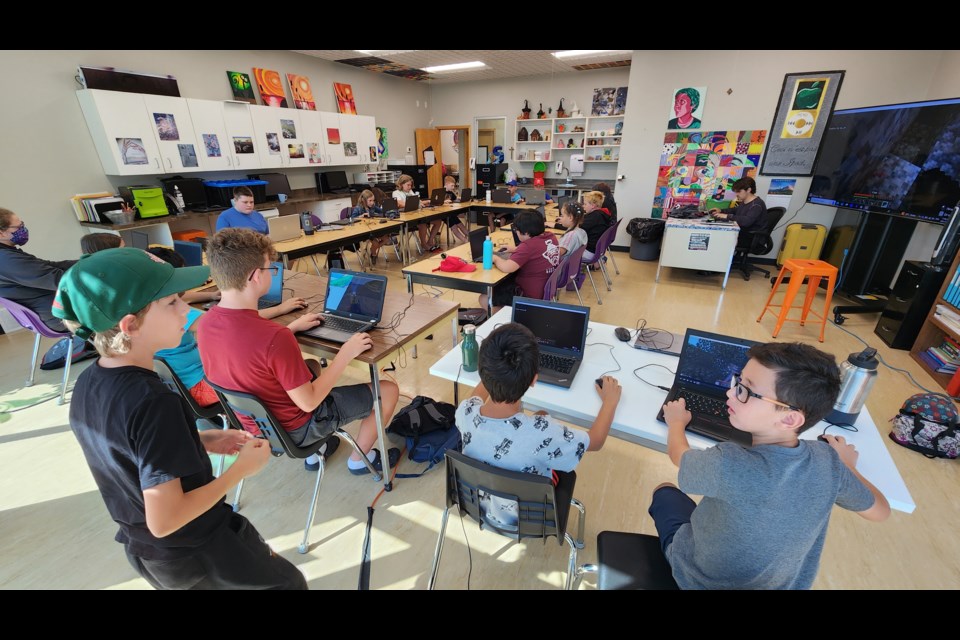The Nanan STEM Academy is holding a summer camp as a partnership with Skills Canada Saskatchewan and Holy Trinity Catholic School Division (HTCSD) that gives students a leg up in the areas of Science, Technology, Engineering, Arts, and Math (STEAM).
Activities at the camp, running from July 31 to August 4 in HTCSD’s Phoenix Academy building, include e-sports with Rocket League and Minecraft, coding with Python, Scratch, and Minecraft Education Edition, painting and other arts activities, 3D printing, math, cultural appreciation and communication, and even some French language skills.
“We’re teaching essential skills, like teamwork, communication, collaboration, resiliency, emotional intelligence, cultural competence, critical thinking, leadership, adaptability — all that stuff,” explained Shaun Nanan, co-founder, academic director, and self-described ‘cheerleader’ at the STEM Academy.
“These are essential skills required for the future of work. We take a non-conventional approach to education. It involves project-based assignments and an exploratory approach to education. The educational philosophy is inspired by Montessori, Suzuki Music Method, and a Zone of Proximal Development.”
Nanan founded the technology-focused academy based on his extensive teaching experience at Sask Polytech, where he was formerly an instructor and Program Head of Computer Engineering Technology. He is now the Academic Chair for the entire School of Computing and Digital Innovation, overseeing multiple technology-related programs.
Nanan and co-founder Zlatan Fazlagic are inspired by the idea of preparing students earlier for modern work realities, but they are also keen to be on the cutting edge of education. They want to be part of the digital revolution in decentralized learning.
“Everything is hands-on and project-based. It’s collaborative and fun and encourages students to explore their interests and appreciate each other’s strengths and difference backgrounds,” Nanan said. “But one of the other main purposes of our program is to decentralize education. It’s the opposite priority of traditional education. I want to reach out and empower even remote communities with the education technology they don’t normally have exposure to.”
With internet-based instruction, Nanan believes the academy has global potential. They have already established classes in Regina, where they partner with Cowessess First Nation and the Saskatchewan Science Centre; in Saskatoon, where instructor Justin Matheson lives; and in Victoria, where Fazlagic lives.
With extensive contacts across industry and education, Nanan says programs in other cities and communities are already actively being developed. The ultimate goal is to make location irrelevant, leapfrogging the slow adaptation of public curriculum to step into the spaces that newer generations are comfortable in: Online gaming, digital communities, virtual reality, and remote work with colleagues around the world.
“The way our course material is designed, it’s all stored in our custom learning management system, including instructional videos and activities that can be adapted for in-person or hybrid or strictly online. So, it’s like a digital textbook.”
Students can join the Nanan STEM Academy long-term for their Saturday after-school programs during the school year. For this one week, though, the focus is on exposure and igniting curiosity.
“They get to do all kinds of things in this one week, just to fuel the fire,” Nanan said. “Here’s some artwork, here’s some coding, robotics, teamwork, games, and all of it collaborating and active.
“It’s not just sitting and memorizing something, or listening to a lecture, then writing a test. It’s all hands-on, so for example, when they’re learning about angles and degrees and trajectories, they actually built their own protractors to learn how to use them. Then, we got them out throwing water balloons to see, you know, what does a zero-degree angle throw do, and 45, and 90?”
With a high-end 3D printer to play with, students learn to cross-apply geometry principles to 3D spaces using Tinkercad to create their own builds. Each student will get the chance to design and print their very own planet as part of a solar system project.
To learn more about Nanan STEM Academy, visit their website at nananacademy.com.




